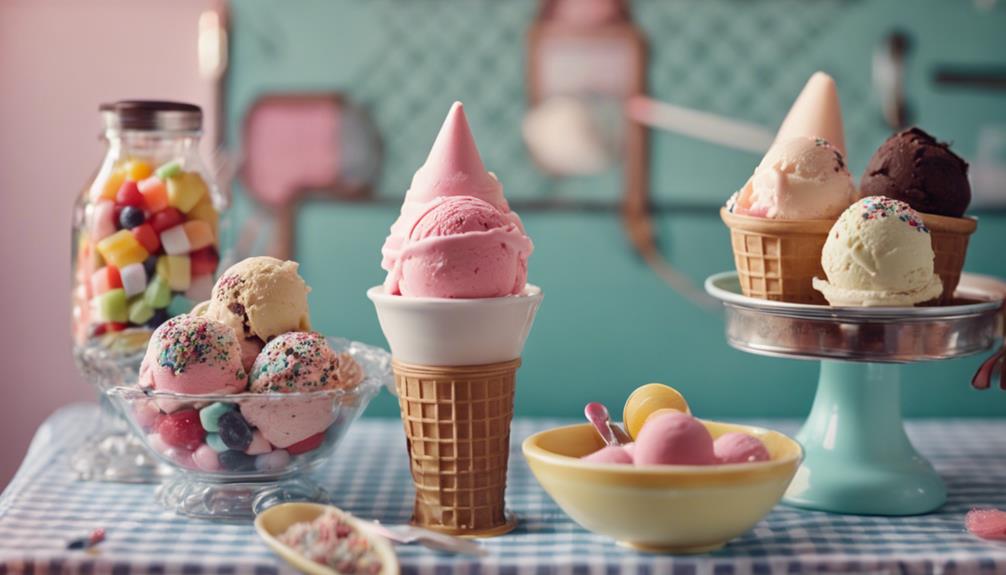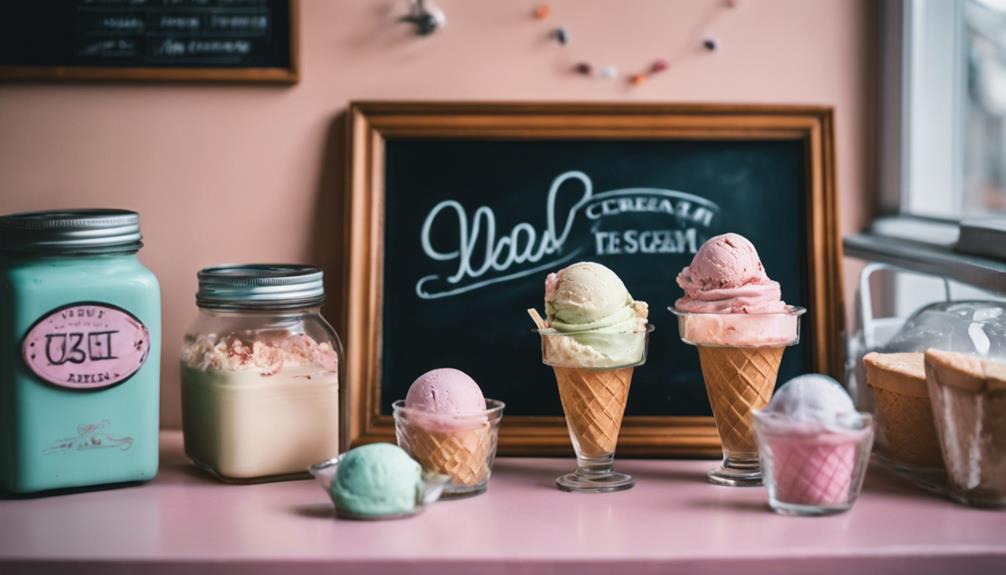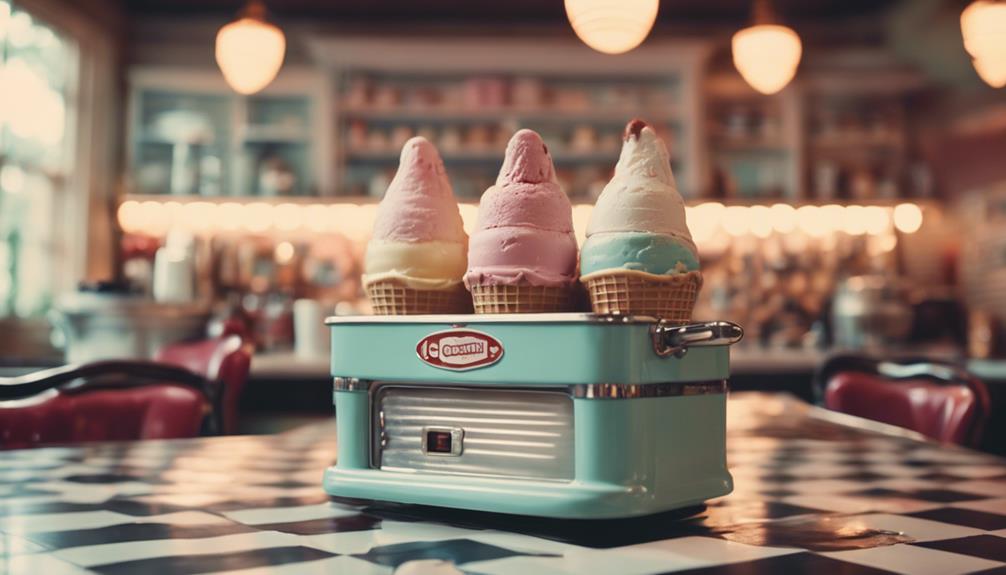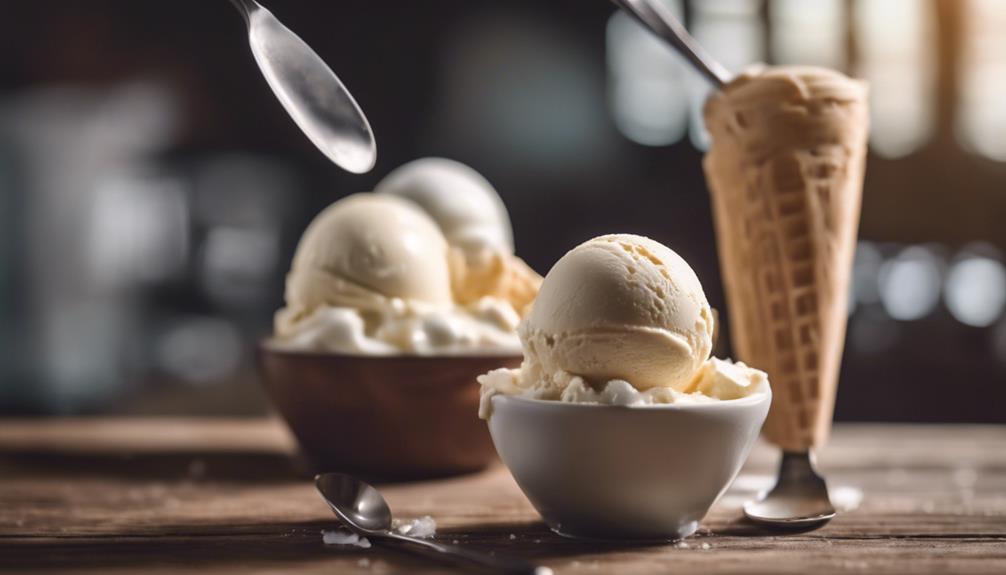Create a nostalgic atmosphere in your house by turning it into a delightful vintage ice cream parlor! Utilize materials like wood, wire, and paint to craft your very own DIY stand. Opt for soft pastel colors and retro signs to maintain an authentic vibe. Don’t forget to include old-fashioned scoops and vintage lighting for that extra flair. Inject some fun and whimsy with vibrant decor pieces. Looking for more ideas? Explore DIY tips and decor suggestions to take your vintage ice cream experience at home to the next level.
Key Takeaways
- Embrace pastel colors and retro decor for a nostalgic feel.
- Set up a vintage-inspired ice cream counter at home.
- Include old-fashioned signs, scoops, and memorabilia for authenticity.
- Design a cozy space with whimsical details for a charming vibe.
- Capture the essence of a classic ice cream parlor with themed elements.
DIY Ice Cream Parlor Stand
Create your own DIY ice cream parlor stand using materials like wood, wire, paint, and metal labels.
To make your ice cream stand truly stand out, incorporate fun decorations that will transport you to a nostalgic vintage ice cream parlor.
Utilize wire coils to mimic ice cream cones on the stand, adding a whimsical touch to the overall look.
For an extra charming detail, place vibrant floral arrangements in empty cones, bringing a pop of color and freshness to your setup.
Ice Cream House Transformation

Transform your house into a charming vintage ice cream parlor by incorporating nostalgic decor elements and creating an authentic home ice cream experience.
Embrace vibrant colors, custom-built furniture, and realistic props to bring the joy of an ice cream parlor to your living space.
From a coffee bar designed like an ice cream counter to colorful dining areas, infuse your home with the fun and whimsy of a retro ice cream shop.
Vintage Decor Elements
To infuse your home with vintage charm reminiscent of an old-fashioned ice cream parlor, consider incorporating pastel colors, retro signs, and whimsical decor elements.
Start by selecting a color palette of soft pastels like mint green, baby blue, and pale pink to evoke a nostalgic feel. Integrate retro signs featuring phrases like 'Ice Cream Parlor' or 'Soda Fountain' to add authenticity to the decor.
Include whimsical elements such as old-fashioned ice cream scoops, vintage ice cream posters, and classic soda fountain chairs to enhance the retro ambiance.
For a complete vintage experience, consider adding checkerboard floors, tin ceiling tiles, and vintage ice cream parlor lighting fixtures to transport you back in time. Display retro ice cream memorabilia, antique milkshake makers, and vintage ice cream parlor menus for an authentic touch.
To elevate the atmosphere further, introduce a jukebox playing oldies music, vintage ice cream sundae glasses, and retro-inspired uniforms for a complete throwback feel. By incorporating these vintage decor elements, you can transform your space into a charming vintage ice cream parlor right at home.
Home Ice Cream Experience
For a delightful twist to your home ambiance, consider revamping your space into a vintage ice cream parlor experience. Transforming your living area into a charming ice cream shop can bring a touch of nostalgia and whimsy to your home.
To create an authentic ice cream parlor vibe, incorporate elements such as pastel colors, retro-inspired furnishings, and playful decor details. Adding vintage signage with phrases like 'Ice Cream Shop' can enhance the overall ambiance and set the mood for a fun ice cream experience.
To complete the transformation, consider adding ice cream-themed accessories like cone-shaped stools and retro ice cream carts. These additions won't only elevate the aesthetic of your space but also provide a unique and enjoyable atmosphere for you and your guests.
Retro Ice Cream Stand Construction

Construct a retro ice cream stand using cardstock, acetate, and acrylic paint to achieve a vintage aesthetic. Utilize a cutting machine to precisely cut out the stand pattern and then assemble it with glue for stability. Enhance the stand by adding details with glitter gel pens, texture paste, and stencils for intricate textures and designs. Consider incorporating a theme such as a beach party or carnival to make the ice cream stand pop at events. To elevate the experience, explore DIY party favors, vibrant decorations, and engaging games that complement the retro vibe of the stand.
| Materials Needed | Tools Required | Techniques |
|---|---|---|
| Cardstock | Cutting Machine | Precise Cutting |
| Acetate | Glue | Assembly for Stability |
| Acrylic Paint | Glitter Gel Pens | Detailed Design |
Ice Cream Social Planning Ideas

When planning your ice cream social, consider incorporating vibrant decorations and engaging games to enhance the overall experience. To create a lively atmosphere, opt for ice cream-themed decor like colorful pastel hues, ice cream cone balloons, and imaginative centerpieces. These elements will set the perfect backdrop for your event, whether you choose a beach party, carnival, or retro ice cream shop theme.
For a delightful treat, set up a DIY ice cream bar with a variety of unique flavors and toppings, catering to all age groups and preferences. Allow guests to customize their ice cream cones with an array of delicious options.
To make the gathering even more memorable, offer personalized DIY party favors such as customized spoons or cups. These thoughtful gestures will leave a lasting impression on attendees.
Incorporating fun ice cream-themed games like pin-the-sprinkles-on-the-cone or a competition to build the tallest ice cream cone will provide entertainment and create a festive atmosphere for everyone to enjoy.
Ice Cream Shop Decor Tips

In creating an authentic vintage experience at home, focus on incorporating classic ice cream parlor decor elements that evoke nostalgia and charm.
When designing your ice cream shop decor, make sure to include vintage elements like retro signs, soft colors, and checkerboard floors for that authentic parlor feel.
Utilize classic ice cream parlor furniture such as soda fountain stools, marble countertops, and Tiffany-style lamps to enhance the vintage ambiance.
Displaying retro ice cream memorabilia like old-fashioned scoops, vintage ice cream makers, and antique ice cream parlor dishes as decor can further elevate the nostalgic atmosphere.
Opt for a traditional ice cream parlor color scheme with gentle pastels, vibrant accents, and whimsical patterns to complete the look.
To create a warm and inviting space, natural light can play an essential role in highlighting these vintage elements.
Incorporating these decor tips will surely transport you and your guests to a bygone era.
Vintage Ice Cream Experience

Get ready to transport yourself back in time with a vintage ice cream experience right in your own home.
Embrace retro ice cream decor, create a whimsical vintage atmosphere, and set up your DIY ice cream stand for a charming trip down memory lane.
Let classic flavors and nostalgic ambiance take you on a delightful journey to the past.
Retro Ice Cream Decor
Create a charming vintage ice cream experience at home by incorporating retro ice cream decor with pastel colors and nostalgic elements. To achieve this, make sure to:
- Use ice cream cone balloons to add a playful touch to the decor.
- Set up whimsical centerpieces that evoke a sense of nostalgia and fun.
- Include colorful props like vintage ice cream scoops and retro signs for an authentic feel.
- Enhance the ambiance with pastel hues, classic signage, and traditional ice cream parlor elements to transport your guests to a bygone era.
Whimsical Vintage Atmosphere
To infuse your home with a whimsical vintage atmosphere reminiscent of a bygone era, consider incorporating pastel colors, retro decor, and nostalgic elements for an authentic ice cream parlor experience. Make sure to include vintage ice cream signage, old-fashioned soda fountain chairs, and checkered floors to truly transport yourself back in time.
Adding vintage ice cream scoops, soda fountains, and glassware can further enhance the retro ambiance, creating a fun idea for a unique ice cream parlor setting at home. Utilize antique ice cream parlor tables, lace curtains, and playful wallpaper to complete the vintage look and feel.
Enhance the overall experience by serving classic ice cream flavors, playing retro music, and paying attention to charming details like old-fashioned milkshake makers. By carefully curating these elements, you can create a delightful and nostalgic atmosphere that captures the essence of a vintage ice cream parlor in the comfort of your own home.
DIY Ice Cream Stand
Construct a charming DIY ice cream stand using wood blocks, wire coils, and paint to enhance your vintage ice cream experience at home.
To create an authentic vintage vibe, make sure to customize the stand with metal labels or chalkboard paint for a personalized touch.
Use wire coils to fashion cone holders, displaying ice cream cones in a charming and nostalgic manner.
For a whimsical touch, consider adding floral arrangements in empty cones, elevating the overall aesthetic of your ice cream stand.
When setting up your DIY creation, position it against a plain wall behind to make the stand the focal point of your vintage ice cream parlor.
By sharing your unique ice cream stand on social media, you can impress your guests and inspire others to craft their vintage experiences at home.
Enjoy the process of designing and showcasing your DIY ice cream stand, adding a delightful touch to your vintage-inspired setting.
Frequently Asked Questions
How Can I Decorate My Ice Cream Shop?
To decorate your ice cream shop, incorporate vintage elements like retro signage, classic furniture, and nostalgic decor. Use pastel colors, checkerboard floors, and chrome accents for a 1950s vibe. Display vintage ice cream scoops, milkshake machines, and soda fountains.
Why Does Ice Cream in a Bag Work?
Ever wondered why ice cream in a bag works? It's all about that salt and ice mix lowering the freezing point, creating a chilly brine that absorbs heat, giving you that creamy homemade treat!
How Does Homemade Ice Cream Work?
To make homemade ice cream, you combine cream, sugar, and flavors, churning the mixture to incorporate air and prevent ice crystals. Freezing it with ice and salt solidifies the mix. Add eggs or stabilizers for better texture.
Who Brought Ice Cream to America?
Quaker colonists brought ice cream to America. They introduced their recipes, sparking its popularity. In 1776, the first ice cream parlor opened in New York City. Thomas Jefferson's preserved recipe showcases its early American roots.
How Can I Recreate the Vintage Ice Cream Parlor Experience at Home Using Richardson’s Ice Cream?
Create the vintage ice cream parlor experience at home by serving Richardson’s tradition of quality ice cream in classic sundae dishes with toppings like hot fudge, whipped cream, and a cherry on top. Add a retro touch with old-fashioned soda floats and classic root beer or cola flavors.
Conclusion
To sum up, creating a vintage ice cream parlor experience at home is a fun and nostalgic way to enjoy a sweet treat with friends and family.
Remember, 'Life is like an ice cream, enjoy it before it melts!'
So gather your loved ones, set up your DIY ice cream stand, and indulge in the magic of a bygone era right in your own kitchen.
Cheers to making memories that are as sweet as can be!









